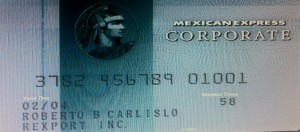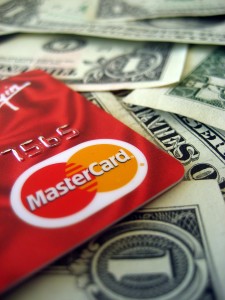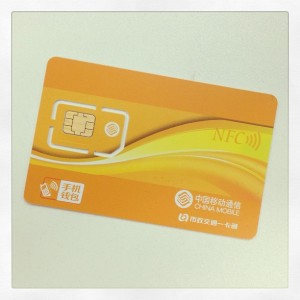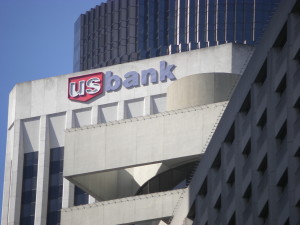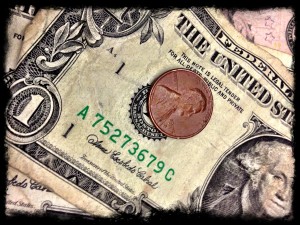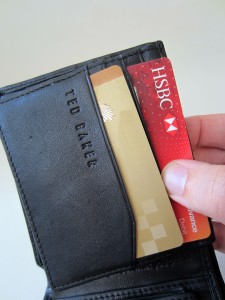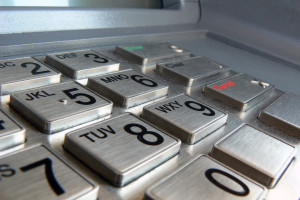Category: Financial Services
December 9th, 2013 by Elma Jane
Credit Cards accepted on the American Express network will be offered by U.S. Bank. in the fall of 2014.
U.S. Bank becomes another major bank to form a partnership with American Express. As previously reported in August, Wells Fargo began issuing new credit cards accepted on the American Express network on a limited basis this year, with a full scale launch planned for the first half of 2014.
Pam Joseph, Vice Chairman of U.S. Bank, said in a statement, We believe that the American Express network provides a combination of benefits and services that many of our customers want.
The cards will be available to bank customers in the 3,088 branches of U.S. Bank, as well as online and by phone. U.S. Bank customers will also have a choice of obtaining a Visa or MasterCard.
Posted in Credit card Processing, Electronic Payments, Financial Services, Visa MasterCard American Express Tagged with: accepted, American Express, credit cards, MasterCard, network, online, U.S. Bank, visa, Wells Fargo
December 5th, 2013 by Elma Jane
Recently, Consumer Reports reviewed 26 different prepaid cards and evaluated them based on different factors. The cards Consumer Reports considered to be the best scored well in each of these four factors:
- Clarity of Fees — How well the fees are disclosed.
- Convenience — Availability of in-network ATMs, bill pay features and how widely the card network brand is accepted.
- Safety — Whether funds are protected with FDIC deposit insurance.
- Value — How much they cost to use.
This is the first time Consumer Reports has evaluated and ranked prepaid cards, revealing a shift in the market for prepaid. As prepaid cards continue to grow in popularity, consumers are going to become savvier about which prepaid cards they purchase. Consider taking a closer look at this Consumer Report to determine how your financial institution’s (FI’s) prepaid offering measures up.
Highest ranked cards are those like the ATIRA suite of prepaid cards TMG’s clients issue. They have fewer fees and make it easier for consumers to avoid them, carry FDIC insurance for each cardholder, offer features comparable to traditional checking accounts and do a better job of disclosing fees.
Not surprisingly, the worst prepaid cards reviewed scored poorly in at least one, and sometimes several, of the above categories. All of the lowest ranked cards have high, unavoidable fees, including activation and monthly fees. Additionally, the lower scoring cards fail to make their fees clear and easy for consumers to access and understand.
Specifically, the report found some prepaid cards fail to provide clear explanations of how to use features such as electronic payments, text alerts and mobile remote deposit capture, and the fees that may be charged for them. Further, while all of the cards reviewed claim to offer some form of protection for consumers, the report found in these policies are often not clearly defined.
Consumer Reports also found it problematic that although issuers provide safeguards voluntarily, they can cancel them at any time. Additionally, according to the report, fee information is often hard to find and difficult to understand. The report states this problem is compounded by the lack of consistency with fee names and descriptions” from card to card, making it challenging for consumers to compare fees and costs. Consumer Reports also found that prepaid cards offered by some of the big banks are not necessarily less expensive than other prepaid cards. Also, these big bank offerings may be less attractive to consumers because they often don’t provide the option of making both electronic payments and payment by paper check.
Posted in Credit card Processing, Financial Services Tagged with: accounts, activation, ATMs, banks, bill pay, card network, cardholder, cards, costs, deposit, electronic payments, fees, financial institution, In-network, insurance, mobile remote deposit capture, monthly fees, paper check, prepaid, text alerts
December 2nd, 2013 by Elma Jane
Europay, Mastercard, and Visa (EMV) standards. Considered safer and widely used across Europe and other nations, the chip-based cards require insertion of the card into a terminal for the duration of a transaction, a break here from our traditional swipe-and-buy behavior. That’s just one way in which EMV changes things here… but it’s not the only way, nor is it the most important way. By way of reminder, October 2015 is the date by which all restaurants and other merchants are due to have implemented these standards, or potentially be liable for counterfeit fraud, which primarily reflects a shift from magnetic-stripe credit cards to chip cards.
The main driver in the EMV migration is card-related financial fraud. As an example, and traditionally, card fraud in the United Kingdom has always been considerably higher than here in the States, primarily because the U.K. previously used offline card authorization as opposed to the online card methodology used here. As losses due to fraud rose steadily in Europe, despite the best efforts of global law enforcement agencies to reduce it, the pressure to find a solution built around some alternative authentication strategy mounted. From this concern, EMV was born.
Is it working? Recent statistics from the European Central Bank (ECB) revealed that, despite growing card usage, fraud in the Single Euro Payments Area (SEPA) – a mature EMV territory that includes all 28 members of the European Union, Finland, Iceland , Liechenstein, Monaco and Norway, – fell 7.6% between 2007 and 2011. This decline is underpinned by a slowdown in the growth of ATM fraud as well as a 24% drop in fraud carried out at point of sale terminals. The 2008 Canadian roll-out of Chip and PIN had a dramatic impact on fraud there. Card Skimming had accounted for losses totaling $142 million, but that figure dropped to $38.5 million in 2009, according to figures provided by the Interac Association. Some critics point to the fact that most of this decrease comes in the form of face-to-face card fraud, and that criminals merely shift their focus onto some other area that is less anti-fraud focused. Still, there are positive gains and as technologies improve, more successes are sure to follow.
Part of the reason why the U.S. not embraced EMV sooner is because our fraud problem, while significant, has typically been among the lowest rates in the world among highly developed economically mature countries. Much of that is due to the online authentication methods at work here. Here at home, our online authentication methodology permits authorizations to be done in real-time, thus thwarting a significant percentage of the fraudulent attempts at the point-of-sale, the best place to stop fraud. Our online authentication methods also incorporate multiple fraud and risk parameters as well as advanced neural networks that are ‘built-in’ to the approval process. It’s been a highly effective system that works well, when compared to most alternatives. The effectiveness of our authentication processes has helped fuel the resistance to full EMV adoption here. However, the EMV migration has gained momentum to the point where it is only a matter of time. The truth is that, despite the gains in preventing credit card fraud, and despite the best efforts of EMV’s backers to push acceptance through, global adoption of the EMV standard is still considerably less than 100%.
In England’s old offline authentication method, credit card transactions were gathered together at specific times- typically, at the end of the business day- and then batched over to the card issuers for authorization. It’s a method that gave those committing fraud a significant time lag between the transaction and the authorization, and this time lag contributed greatly to the higher levels of fraudulent activities in England. However, for Europe and for much of the rest of the world, adoption of the EMV technologies changes things dramatically, at least in terms of authentication protocols for both online and offline purchases. During an offline transaction using the EMV chip card, the payment terminal communicates with the integrated circuit chip (ICC), embedded in the payment card. This is a break from the old method which involved using telecommunications to connect with the issuing bank. The ICC / terminal connection enables real-time card authentication, cardholder verification, and payment authorization offline. Alternatively, in an online EMV transaction, the chip generates a cryptogram that is authenticated by the card issuer in real time.
Posted in Electronic Payments, EMV EuroPay MasterCard Visa, Financial Services, Near Field Communication, Payment Card Industry PCI Security, Visa MasterCard American Express Tagged with: authentication, batched, card, card authorization, card-related, chip cards, chip-based, credit cards, cryptogram, EMV, EuroPay, financial, fraud, fraudulent, icc, insertion, integrated, magnetic stripe, MasterCard, Merchant's, networks, online, payment, restaurants, Skimming, standards, swipe-and-buy, terminal, transaction, verification, visa
December 2nd, 2013 by Elma Jane
U.S. Bank has announced the U.S. Bank Contour Card – saying that the new card gives customers the convenience of a debit card, the control of a bank account and the freedom of cash. Giving customers innovative options to manage their finances. The Contour Card is the latest example. It’s a great tool to manage expenses by giving you the power to budget your money across multiple prepaid cards under the same account. Customers can use Contour as their primary payment card, but it is also a good fit for anyone who wants a new way to manage money.
Contour gives control over your spending in so many ways. From tracking your spending to transferring money between accounts, Contour gives customers the ability to manage it all from one location through their personal My Contour Dashboard.
Cardholders can open up to five additional card accounts that can be linked to their primary account. Cardholders can use Contour anywhere Visa Debit cards are accepted, get free cash withdrawals at any U.S. Bank or MoneyPass ATMs, and direct deposit paychecks to their accounts at no additional charge.
Posted in Financial Services Tagged with: account, ATMs, budget, card, cardholders, debit card, deposit, finances, money, MoneyPass, paychecks, prepaid, tracking, tranferring, U.S. Bank, US Bank, visa, withdrawals
November 18th, 2013 by Elma Jane
Big players are entering the merchant cash advance business and the industry’s smaller players are maturing. Meanwhile, the market is growing with the help of automated clearinghouse transactions.
The industry has caught the attention of high rollers who are transforming merchant cash advance into a mainstream option for funding small to midsize businesses.
In the past two years, venture capitalists and hedge funds have invested tens of millions of dollars in long-standing merchant cash advance firms and startups alike.
Meanwhile, big players such as PayPal and the card brands have launched their own programs to provide working capital to merchants.
The business has changed so much in the five years, it’s almost not the same business anymore, says a hybrid ISO and merchant cash advance company based in New York.
CEO of Capital Stack LLC, a merchant cash advance company in New York, has been monitoring the industry’s growth on his DailyFunder blog. He estimates that a year ago, there were about 50 merchant cash advance funders and about $1.5 billion in funding. This year, that number is north of 120, and the funding volume has doubled to $3 billion.
Counting mainstream funders such as Amazon and PayPal, which offer products that follow the cash advance model, the numbers are closer to $5 billion.
Until now, ISOs were using cash advances as an acquiring tool for credit card accounts. An estimate that of the 20 million to 25 million businesses in the U.S., about 5 million accept credit cards. When ACH opened up the remainder of those businesses for loans, the funding volume went off the charts. Now it’s going to grow 50-fold in a 10-year period, just because there are so many more businesses that are approvable.
The popularity of cash advance is good news for ISOs, who might have an easier time pitching the product to merchants because they already know about it and know to ask for it.
A number of factors have coincided to make merchant cash advances more attractive.
Previously, cash advances were associated with luring merchants into a high-rate source of cash. Funders could charge any rates they wanted because the industry was so unregulated. As the industry has matured, the more disciplined companies have survived, while the others have fallen by the wayside, and with the recession causing fewer banks to offer traditional loans, the market is wide open for alternative funders of all shapes and sizes to enter the fray.
The industry has also outgrown the one-size-fits-all pricing that once defined it. Before, all lenders set high prices. Now, companies rely on risk-based pricing, which means better clients get better deals, and ISOs can offer more competitive pricing. That changed the dynamics of the industry.
But the real change in merchant cash advance, members of the industry say, has been the widespread use of automated clearinghouse payment transfers. It used to be that merchant cash advance was available only to companies that accepted credit cards. Now with more businesses accepting payments online via ACH, there is another mechanism for collecting from merchants.
It took some time for people to accept people going into their bank account and debiting their account. Five or six years ago, no one would have allowed someone to do something like that.
Today, everybody’s fundable, as long as you have a bank account. Gone are the days when ISOs had to walk away from potentially big deals because the merchant didn’t accept credit cards, or didn’t have enough processing volume. ISOs and merchants now have more flexibility to walk into just about any business and offer financing. That’s why it’s mainstream.
Posted in Best Practices for Merchants, Financial Services, Merchant Cash Advance Tagged with: accept credit cards, accounts, ach, acquiring, Amazon, approvable, automated, clearinghouse, credit-card, funders, funding, high rate, high rollers, ISO, merchant cash advance, PayPal, traditional loans, transactions, unregulated, venture capitalist, working capital
November 14th, 2013 by Elma Jane
Micropayments provide faster results and some immediate gratification that can keep you motivated. Rather than eating out or splurging on something that you don’t really need, immediately apply that money to pay down your credit card balance. Instead of paying a certain amount once a month, divide that payment in half and pay that amount every two weeks. Consumers can even sign up for an electronic transfer of your funds to take place every two weeks. By the end of the year, you will have made 26 payments or the equivalent of 13 monthly payments. The extra monthly payment resulting from this payment plan will enable you to pay down your debt at a faster pace.
If you are planning to make micropayments, consumers may want to call their credit card company to verify that separate payments can be made and will be credited to their monthly minimum. See if your issuer has any restrictions or limitations on making additional payments.
Holiday shopping is just around the corner, and consumers need to have their credit card balances as low as possible in order to avoid costly interest charges. One way to do this is to make micropayments on their credit card bill. While we are conditioned to pay our credit card bill once a month, consumers can actually make a number of smaller payments throughout the month. Some banks and issuers allow payments to be made as often as once a day. If you carry a balance, micropayments can reduce the interest because most credit card companies charge interest based on your average daily balance during the month. Pay more often and you reduce your average daily balance and therefore the interest you pay that month.
If you have more than one card with a balance, keep paying the minimums for each card, but pick one card to pay off first. Select either the card with the highest interest rate (save more money) or the card with the lowest balance (pay it off faster). Stop charging on that card, using another card for purchases.
There are several other advantages to making micropayments when paying down credit card debt:
You may have better control of your payments. If you are paid weekly or bi-weekly, money can slip away by the end of the month. Designate a specific day after you are paid to send in a payment for your credit card. Four $50 payments or two $100 payments are sometimes easier to make than a monthly $200 payment. It is also easier to add a little extra money to smaller payments.
In time, micropayments can help raise your credit score. An organized, scheduled payment plan can help you avoid late payments and pay more than the minimum due. Both of these are important elements for a good credit score.
Micropayments can reduce financial stress. Making payments right after payday at a time when you actually have the money will likely reduce anxiety and financial stress.
The higher your interest rate, the more you will save.
The disadvantage to the micropayment plan is that it takes time, organization and financial discipline to make the plan work and this may be difficult for some people.
Posted in Electronic Payments, Financial Services, Visa MasterCard American Express Tagged with: balance, bill, consumers, credit-card, credited, debt, elements, financial, interest, issuers, limitations, micropayments, money, monthly minimum, pay, payments, purchases, shopping
November 8th, 2013 by Elma Jane
If you want to make the most out of your shopping adventures, you need to have a credit card that helps you save money. The question is, which option is better for you? Some people automatically think about store credit cards, and others go for cash back credit cards. Before you apply for a card, assess which type of card would be more beneficial for your personal needs.
Cash Back Credit Cards
The main perk to having a cash back credit card is the fact that you can use it anywhere. It still acts as a traditional credit card. The only difference is that you get rewards from the money you spend on it. The average cash back credit card offers 1% cash back on all purchases. Some may also pay an additional 2% to 5% cash back on select purchases made with the card. Example, the Citi ThankYou Preferred Card offers 2 reward points per $1 spent on dining and entertainment. Blue Cash Everyday card from American Express offers 3% cash back at supermarkets, 2% cash back at gas stations and 1% on all other purchases. You could earn a great deal of your money if you choose the right cash back card and use it correctly.
The problem with cash back credit cards is that the rewards structure can sometimes be confusing. The Discover It Card features an attractive rewards program, but its 5% cash back offer changes every three months. It may be on home improvement purchases during one quarter, but during another quarter, it may be applicable on purchases at gas stations and for holiday shopping. You have to keep up with the rewards calendar to get the most out of your credit card. You also have to consider any fees associated with your credit card. Some cash back cards on the market have an annual fee, and many have a slightly higher interest rate than the average card. Review the terms of any card you are considering for so you can pick the perfect one for you.
Store Credit Cards
Store credit cards are usually easy to apply for and just as easy to obtain. Some of them can be used like regular credit cards, and others have to be used at a specific store. For instance, the traditional Walmart credit card can only be used at Walmart, but the Walmart Discover card can be used anywhere Discover is accepted. You need to know this about your card before applying for it. Many people get a store credit card because they receive some type of introductory offer when they apply for one. You might be able to save 10-15% off your initial purchase, or you might get a certain amount of cash back after making your first purchase. These offers are designed to lure you into getting a card, even though you may never use it again. What you may not realize in the euphoria of the introductory offer is the very high interest rate you typically have on a store credit card.
When you start looking at store credit cards, consider what kind of rewards you can get and how those rewards are accumulated. Do they only come from purchases at that store, or do they come from any transaction? Are you required to use rewards in the store, or can you use them online? Does the card have an annual fee? You must go through this type of analysis before deciding if a store credit card is worth getting.
Are Cash Back Credit Cards Better Than Store Credit Cards?
In our opinion, yes. This isn’t because we’re biased towards cash back cards. We just like the idea that you can earn rewards wherever you make a transaction. You aren’t limited to one store, either in the way you spend money or the way you collect your rewards. In addition, store cards usually have a higher interest rate. With that said, there are people who benefit from store credit cards because they shop at those stores all the time. If you spend thousands of dollars a year at Lowe’s for your construction company, a Lowe’s credit card may provide substantial savings for your business.
Don’t get overly excited when you reach the checkout counter. That one-time savings on a store credit card may not be worth it in the end. Think over your shopping habits and see if a cash back credit card is more suited for your needs. If so, you have plenty of them to choose from.
Posted in Electronic Payments, Financial Services, Gift & Loyalty Card Processing, Visa MasterCard American Express Tagged with: %, accumulated, American Express, annual, assesses, average, beneficial, calendar, cash, cash back, checkout, credit cards, dining, Discover, earn, entertainment, fee, improvement, interest, lowe's, market, money, online, pay, points, preferred, purchases, quarter, rate, rewards, savings, shopping, store, traditional, transaction, walmart
October 29th, 2013 by Elma Jane
Three dimensions merchants must look for in a payment system PSP and ISO:
1. Ability to adapt and customize the solution.
2. Solutions that support broad range of payment methods.
3. Supports a full set of different channels and devices.
Difference between a PSP and ISO in the payments ecosystem? Online and Mobile Payments:
There are two types of merchant service providers and not all service providers are made equal, Processors and Resellers:
Resellers are known in the industry as Independent Sales Organizations (ISO’s) and/or Merchant Service Providers (MSP’s).
1) Resellers or ISOs – ISOs resell the products or services of one or multiple processors. They can also develop their own or aggregate other value added products and services. ISO’s range from a little sketchy to best in class providers.
2) Processors – Also known as Acquirers, processors are distinguished by their ability to actually process a transaction. To be a processor, a company must have the technical capability to receive transaction data from a merchant via a telephone line or the internet and then communicate with the appropriate financial institutions to approve or decline transactions. Processors must also be able to settle completed transactions through financial institutions in order to deposit funds into the merchant’s bank account.
Processors can be banks or non-banks. While processors do maintain a direct sales force of their own, they primarily work through ISOs to acquire and maintain their merchant base. A processor’s business model is really one of economies of scale. They’re volume shops. They essentially outsource the sales function to ISOs. The processing industry is highly concentrated with the top five processors maintaining over 70% of all transaction volume.
Types of ISOs:
1. Banks – Banks of all shapes and sizes are ISOs. Banks entered into the merchant services business because it was a natural fit with their product and service offerings. It’s a way to increase revenue per customer. Most, but not all banks, will private label the services so that it’s difficult to distinguish whether they are a processor or ISO. The benefit of working with a bank is that you can consolidate your financial services. The drawback is, the you usually get out of the box solutions and service.
2. Non-banks – These types of ISOs range from some of the most dynamic and capable providers to firms who don’t represent the industry very well.
Industry Dynamics – There are a few dynamics that make the industry landscape quite interesting. First, there are very barriers to entry due to the lack of certifications, licenses, and capital requirements. Secondly, there really is no active regulatory body that oversees and enforces acceptable practices. So naturally, with these two market conditions, merchants need to be mindful and thorough in selecting a provider.
Processors versus ISOs In comparing the two, ISOs offer all of the products and services that processors do (because they are reselling) but processors can’t always offer the same products and services as ISOs. This is because ISOs can resell for multiple processors and can either develop their own technologies or aggregate solutions from other providers. ISOs have largely been the most successful creators of value-added services. ISO’s also tend to be smaller, which usually (but not always) leads to better customer service.
Processors are usually a safer bet for newer merchants that are still learning about the industry. Most still maintain what consider less-than-upfront pricing practices, but with their services it is less common to hear about some of the more serious problems that merchants encounter when they deal with the wrong ISO. As for price, in most cases, there really is very little to no difference. I argue, and fully disclose my vested interest, that in nearly any situation a best in class, non-bank ISO can provide more value than a processor.
Posted in Best Practices for Merchants, Credit card Processing, Electronic Payments, Financial Services, Mail Order Telephone Order, Merchant Services Account, Visa MasterCard American Express Tagged with: account, acquirers, aggregate, approve or decline, bank, best in class, channels, customize, data, deposit, devices, financial, independent sales organizations, internet, ISO, merchant service providers, Merchant's, mobile, msp, non-banks, online, payment methods, payment system, payments, processors, psp, resellers, solution, telephone, transaction, value added
October 24th, 2013 by Elma Jane
Buoyed by an improving economy, business travelers are once again taking to the skies and spending more on corporate travel. The Global Business Travel Association has projected that $273.3 billion in travel dollars will be spent in 2013, and “that’s a whole lot of spending for corporate travel managers and individual business travelers to evaluate and track.”
Recognizing this problem, MasterCard launched Travel Controller on October 21. The new product is designed to give corporate users greater control over their travel expenses by directly addressing data concerns.
“Companies today are more than ever looking for more and better ways to help manage their corporate travel expense, to manage travelers that are outside of policy, and most importantly, reduce the amount of money they spend on travel.
Travel Controller is designed to be a modern solution to the problems posed by traditional lodge cards. Unlike these options, Travel Controller allows corporate users to identify individual travelers, trips and transactions, providing businesses greater insight into this spending than the available offerings that dominate the market.
Travel controller uses latest virtual card technology to generate a unique account number for each individual transaction, each hotel reservation and each ticket that’s purchased. And when its generating that card, it captures that data that’s important to the company for how they manage that.
Whether that’s the details of the transaction or things more specific to the trip or traveler or the way the company manages its budgets, all of this information is provided 100 percent of the time. This removes the headaches associated with central travel while still giving that control element that companies are looking for.
Travel Controller is around the goals of an end user organization, as a company that’s trying to manage their travel expenses more effectively.
There is a defined data set, and built in flexibility for companies to define their own customer-specific fields, that are important so that the data you get back isn’t just thousands of pieces of information, but rather its those things that are most important and its brought to you in a way that makes it easy to take advantage of.
Posted in Best Practices for Merchants, Credit card Processing, Financial Services, Merchant Services Account, Travel Agency Agents, Visa MasterCard American Express Tagged with: account, addressing, amount, association, business, card, controller, corporate, data set, dollars, dominate, element, expenses, generating, global, improving, individual, information, lodge, market, MasterCard, money, policy, reduce, spend, spending, traditional, transactions, travel, travelers, trips, unique, virtual
October 15th, 2013 by Elma Jane
Banking and payments technology provider FIS and City National Bank, a private and business bank, have partnered to pilot FIS’s Cardless Cash Access at City National ATMs in Los Angeles, New York City and San Francisco. The solution lets consumers stage an ATM transaction from their mobile devices.
City National plans to introduce the emerging technology to clients in its three largest markets early next year, according to an FIS announcement, continuing FIS’ rollout of the solution at banks and ATMs in key U.S. locations.
FIS said Cardless Cash Access securely authenticates a user on his or her smartphone. The consumer then uses the phone to select the account and amount of the withdrawal. At the ATM, the consumer scans a QR code on the ATM screen and, within seconds, the cash is dispensed and an e-receipt is sent to the phone.
Consumers continue to look for innovative new ways to engage with their financial institutions via mobile devices, FIS Mobile, said in the release. At the same time, they demand additional security to keep their information safe. Information from Cardless Cash Access is maintained in the cloud, so card data cannot be accessed if the consumer’s phone is lost or stolen – making this a faster, safer, more secure way to make a withdrawal.”
To decrease fraud, FIS said, security within Cardless Cash Access is provided through the app’s authentication and registration of a user’s smartphone, which the company said eliminates card skimming risk and fraud incidents for banks and their clients.
With the proliferation of debit and access to cash at the point of sale, financial institutions are looking for ways to expand the utility of the ATM,” Senior vice president and head of product strategies, Vince Hruska, City National Bank, said in the release. “Cardless Cash Access not only provides a secure and easy way to obtain cash from an ATM, but introduces to the client a new way of looking at ATM use.
Posted in Financial Services Tagged with: account, amount, atm, authenticates, banking, banks, card, cardless, cash, data, e-receipt, emerging, financial, Mobile Devices, national, payments, QR code, securely, Security, Skimming, smartphone, transaction
